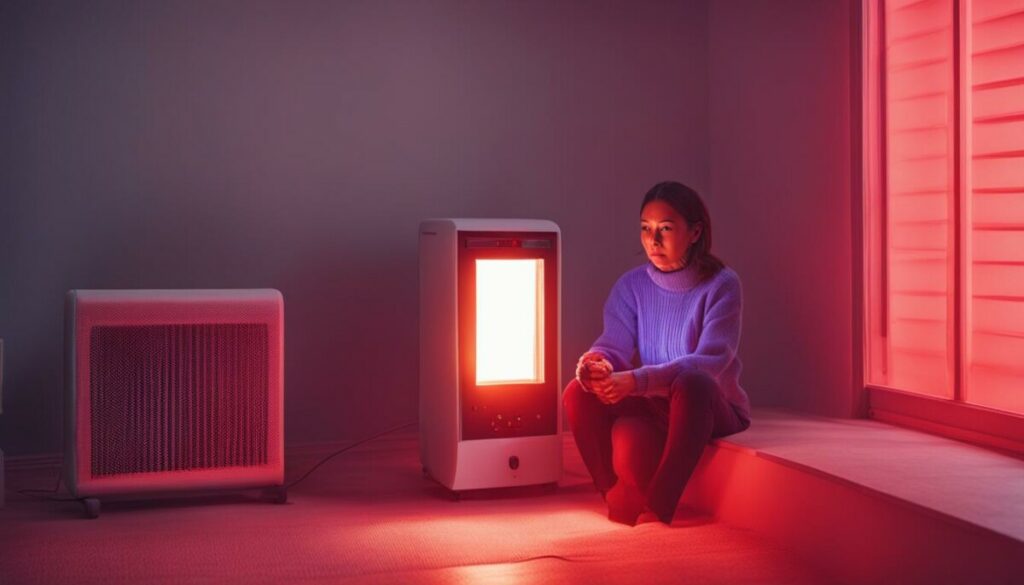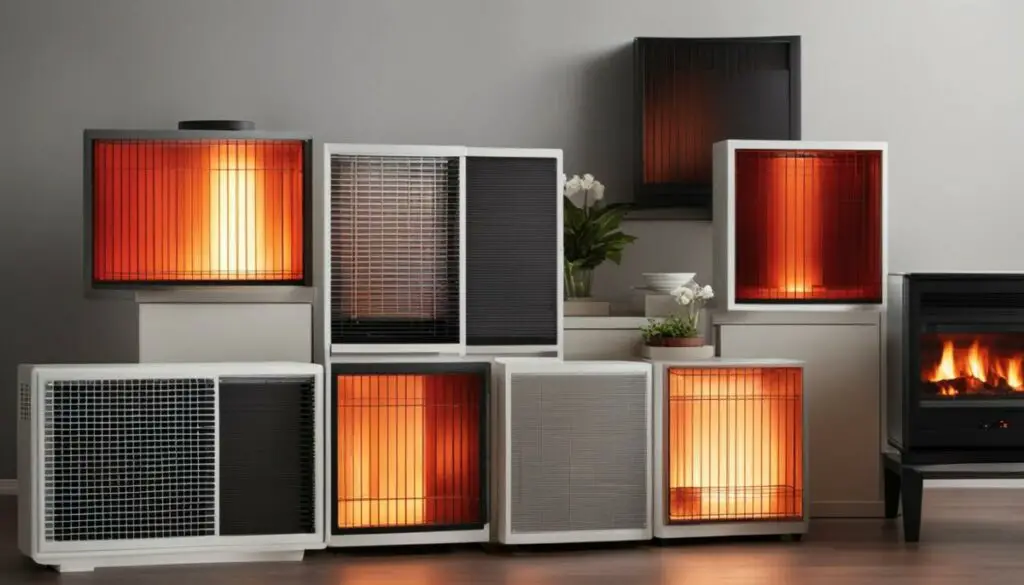Last Updated on 6 months by Francis
When it comes to heating your home or office, there are a variety of options available on the market. One option that has been gaining popularity in recent years is infrared heating.
Infrared heating works by emitting infrared radiation, which heats up objects and people within its immediate vicinity. While there are some advantages to using this technology, such as its energy efficiency and low maintenance requirements, there are also several disadvantages that should be considered before making a decision.
In this article, we will explore the various drawbacks and limitations of using infrared heating as a heating solution. From its limited heating range to safety concerns, we will discuss the negative aspects and potential problems associated with this technology.
Contents
Key Takeaways
- Using infrared heating may result in a limited heating range
- Infrared heaters may have uneven heating distribution, resulting in hot and cold spots
- They require a direct line of sight between the heater and the objects or people being heated
- Infrared heaters typically have a slower heating time compared to other heating systems
- They can consume more energy compared to other heating systems, resulting in higher utility bills
Understanding How Infrared Heating Works

Infrared heating technology is based on the principle of electromagnetic waves that travel through space and transfer energy to various objects and surfaces. Unlike traditional heating methods, which rely on convection heating to warm and circulate air, infrared heating transfers heat directly to people and objects within its immediate vicinity.
At the core of infrared heating technology are special heating elements that emit infrared radiation. These elements are typically made of materials such as quartz, ceramic, or metal and are heated to high temperatures to emit infrared waves.
When these waves come into contact with objects and people, they are absorbed and converted into heat, warming them up directly. This direct heating method is why infrared heaters are often referred to as radiant heaters.
Infrared heating technology is not a new concept and has been used for various applications, from drying paints and coatings to keeping food warm. However, in recent years, it has gained popularity as a heating solution for homes, offices, and other commercial spaces.
One of the primary advantages of infrared heating technology is its energy efficiency. Since it heats objects and people directly, it does not waste energy in heating the air, making it a more environmentally friendly option compared to traditional heating methods.
Another benefit of infrared heating technology is its versatility. It can be used as a primary heating source or as a supplemental heat source to complement existing heating systems. It is also available in various forms, including wall-mounted panels, freestanding heaters, and outdoor patio heaters.
Types of Infrared Heating
There are two main types of infrared heating technology: near-infrared and far-infrared.
- Near-infrared: This type of infrared heating is used for applications that require high-temperature heating and rapid drying, such as in manufacturing or food processing industries. It is also used in medical and therapeutic applications, such as infrared saunas.
- Far-infrared: This type of infrared heating is typically used for heating indoor and outdoor spaces. It emits lower levels of radiation and operates at lower temperatures compared to near-infrared heating, making it a safer and more comfortable option for people and pets.
Knowing the different types of infrared heating can help individuals select the most suitable option for their specific heating needs.
Limited Heating Range

One of the most significant limitations of infrared heating is its limited heating range. Unlike traditional heating systems that evenly distribute heat throughout a room, infrared heaters primarily heat objects and people within their immediate vicinity.
This means that if you’re sitting or standing too far away from the heater, you may not feel its warmth, making it less effective in larger rooms or spaces with high ceilings.
| Heating System | Effective Range |
|---|---|
| Infrared Heating | 10-15 feet |
| Forced Air Heating | 550-700 square feet |
| Radiant Heating | 100-250 square feet |
Uneven Heating Distribution

Infrared heaters have a directional heating system, which means that the heat is focused in a specific direction. This heating method may result in uneven heating distribution, which can cause hot and cold spots in a room. The heating elements in the infrared heater may struggle to heat areas that are not in the line of sight, such as corners or spaces behind furniture.
As per a study conducted on the efficiency of different heating systems, it was found that infrared heaters have lower heating efficiency when compared to other heating systems. This could be attributed to their directional heating and limited reach, which leads to uneven heating distribution.
“Infrared heaters may not provide consistent warmth across an entire room, resulting in hot and cold spots.”
It is important to consider the layout of a space when choosing an infrared heater to ensure that the heating system is efficient and effective. Placing the heater in an area where it can directly heat the most-used spaces can help mitigate the issue of uneven heating distribution.
Dependency on Line of Sight

One of the major disadvantages of using infrared heating is that it requires a direct line of sight between the heating element and the object or person being heated. This means that any obstacles, such as furniture or walls, can block the heat and reduce its effectiveness. For example, if you place an infrared heater in the corner of a room and the couch is blocking its line of sight, the heat will be minimized, and the room will not warm up as quickly as expected.
To demonstrate the importance of line of sight, let’s look at a comparison between infrared heating and another common heating system: forced air heating.
| Heating System | Advantages | Disadvantages |
|---|---|---|
| Infrared Heating | – Heats objects and people directly – No heat loss through ducts |
– Requires direct line of sight – Inefficient for large spaces – Slow heating time |
| Forced Air Heating | – Heats entire room evenly – Quick heating time |
– Heat loss through ducts – Can be noisy – Higher energy consumption |
As we can see from the comparison table, infrared heating has the advantage of heating objects and people directly, without losing heat through ducts. However, it’s important to note that it requires a direct line of sight, making it inefficient for larger spaces and slower in heating time.
Overall, while infrared heating may be a suitable solution for some situations, its dependency on line of sight may be a significant disadvantage for others. It’s essential to consider the layout and obstacles in the heating area before deciding on an infrared heating solution.
Slow Heating Time

One of the most significant infrared heating problems is its slow heating time. Because infrared heaters primarily heat objects and people within their immediate vicinity, it may take longer for a room to reach the desired temperature compared to traditional heating systems.
This slow heating time can be especially problematic in larger spaces, where the heat from the infrared heaters may take longer to circulate and warm up the entire area. This means it can take longer to achieve a comfortable temperature, leading to potential discomfort for individuals in the space.
It’s important to consider the heating needs of your space before choosing an infrared heating system. If your space requires quick and consistent heating, an infrared heater may not be the best option.
Higher Energy Consumption
Infrared heating may seem like an affordable option due to its relatively low upfront cost. However, it’s essential to consider the long-term energy consumption and associated costs. Infrared heaters can consume more energy compared to other heating systems, especially if used as the primary source of heat. This increased energy consumption can lead to higher utility bills, which can be a significant drawback for those on a tight budget.
According to a study by Energy.gov, a 1500-watt infrared heater used for eight hours a day can add up to $54 to your monthly electric bill. In contrast, a traditional electric heater with a fan costs only $36 for the same period. This higher consumption can be attributed to the way infrared heaters work, primarily heating objects and people instead of the air, resulting in more energy use to achieve a comfortable temperature.
There are some ways to mitigate this higher energy consumption, such as using the infrared heater to supplement other heating methods, such as central heating or using it only in small spaces. However, before opting for infrared heating, it’s crucial to consider the long-term energy costs and how they fit into your budget.
Limited Thermostat Control

One of the drawbacks of infrared heating technology is that some heaters have limited thermostat control options. This means that it can be challenging to maintain a consistent and comfortable temperature throughout the day.
Unlike traditional heating systems that can be programmed to adjust the temperature automatically, many infrared heaters require manual adjustments. This can lead to potential discomfort for individuals who may forget to adjust the thermostat during the day.
In addition, some infrared heaters may only offer a few temperature settings, making it difficult to fine-tune the temperature to individual preferences.
| Drawback | Impact |
|---|---|
| Limited thermostat control | Challenging to maintain a consistent and comfortable temperature throughout the day |
| Manual adjustments | Potential discomfort for individuals who may forget to adjust the thermostat during the day |
| Few temperature settings | Difficult to fine-tune the temperature to individual preferences |
To mitigate this drawback, individuals may want to consider purchasing an infrared heater with more advanced thermostat control options. For example, some infrared heaters come equipped with programmable thermostats that allow users to set a heating schedule and adjust the temperature remotely.
“Infrared heaters may offer limited thermostat control options, which can make it challenging to maintain a consistent and comfortable temperature throughout the day.”
Not Suitable for Large Spaces

While infrared heating can be effective in smaller rooms, it may not be suitable for larger spaces. Rooms with high ceilings or open floor plans may not retain heat as well, resulting in less efficient heating. According to a study conducted by the Department of Mechanical and Aerospace Engineering at Western Michigan University, “infrared heaters require a higher wattage per square foot when used in large areas, making them less efficient and more costly than traditional heating methods.”
| Pros of Infrared Heating | Cons of Infrared Heating |
|---|---|
| Energy efficient heating of small spaces | Less efficient for large spaces |
| Comfortable heat that does not dry out the air | Potentially higher energy consumption compared to other heating systems |
| Minimal maintenance required | Uneven heating distribution resulting in hot and cold spots |
As seen in the table above, while infrared heating has its advantages in small spaces, it falls short when it comes to heating larger areas. It’s important to consider the limitations of this technology and determine if it’s a suitable option for your specific heating needs.
Safety Concerns
While infrared heating is generally considered safe, it is not without its negative aspects and safety concerns. It is important to be aware of these potential issues to maximize safety and prevent accidents.
- Burns: The heating elements in infrared heaters can become quite hot. Direct contact with these elements can result in burns. It is important to keep flammable objects away from the heaters and to avoid touching the heating elements while they are in use.
- Fire: As with any heating system, there is a risk of fire if the equipment is not used properly. It is important to follow all manufacturer instructions and to ensure that the heater is not left unattended while in use.
- Electric shock: Infrared heaters are powered by electricity, which means there is a risk of electric shock if the equipment is not maintained properly, or if there is damage to the electrical components. It is important to follow all safety precautions and to have the heater inspected regularly by a qualified professional.
- Inhalation of toxins: If an infrared heater is not maintained properly, it can emit harmful toxins such as carbon monoxide. This can be particularly dangerous in small, enclosed spaces. To prevent this, it is important to ensure proper ventilation in the room where the heater is being used, and to have the heater inspected and cleaned regularly.
- Tip-over: Many infrared heaters are designed to automatically shut off if they are tipped over. However, if this feature is not present or if it fails to work properly, there is a risk of the heater causing a fire or other safety hazard. It is important to follow all manufacturer instructions regarding the proper use and placement of the heater.
In conclusion, while infrared heating is generally safe, there are several safety concerns that must be taken into account. These include the risk of burns, fire, electric shock, inhalation of toxins, and tip-over. To minimize the risk of accidents, it is important to follow all manufacturer instructions, have the equipment inspected regularly, and to keep flammable objects away from the heater.
Limited Aesthetic Options
When it comes to interior design, infrared heaters may not be the best option for everyone. Unlike traditional heating systems that can be integrated into the décor, infrared heaters often have a utilitarian design that may not fit well with certain home styles or design preferences.
While there are sleeker designs available on the market, these options can be more expensive and may not be as widely available as the standard models.
For those who prioritize aesthetics in their home, the limited options for infrared heaters may be a drawback to consider.
“Unlike traditional heating systems that can be integrated into the décor, infrared heaters often have a utilitarian design that may not fit well with certain home styles or design preferences.”
Conclusion
After exploring the various drawbacks and limitations of infrared heating, it is clear that this technology may not be the best solution for everyone. While it has some advantages, there are several negative aspects that should be taken into consideration when choosing a heating system.
Infrared heating has a limited heating range and may have uneven distribution, making it less efficient for larger spaces. It also requires a direct line of sight and may have slower heating times, which can be challenging in certain situations. Additionally, infrared heaters can consume more energy, leading to higher utility bills, and may have limited thermostat control options.
Safety concerns, such as the risk of burns, are also present with these heaters. Lastly, limited aesthetic options may not fit well with certain décor styles or interior design preferences.
While infrared heating can be a viable option in some cases, it is important to weigh the pros and cons before making a decision. By understanding the limitations of this technology, individuals can make an informed choice that best suits their heating needs.
FAQ
What are the disadvantages of infrared heating?
Infrared heating has several drawbacks, including limited heating range, uneven heating distribution, dependency on line of sight, slow heating time, higher energy consumption, limited thermostat control, inefficiency in large spaces, safety concerns, and limited aesthetic options.
How does infrared heating work?
Infrared heating works by emitting infrared radiation, which heats objects and people directly rather than heating the air. This radiation is absorbed by objects, causing them to release heat and warm the surrounding environment.
What is the limited heating range of infrared heating?
Unlike traditional heating systems, infrared heaters primarily heat objects and people within their immediate vicinity, resulting in a limited heating range. The heat does not distribute evenly throughout an entire room.
Why is there uneven heating distribution with infrared heating?
Infrared heaters emit directional heat, which can result in uneven heating distribution. This means that certain areas of a room may be warmer than others, creating hot and cold spots.
Does infrared heating require line of sight?
Yes, infrared heaters require a direct line of sight between the heater and the objects or people being heated. Obstacles such as furniture or walls can block the heat, reducing its effectiveness.
How long does it take for infrared heating to heat up a room?
Infrared heaters generally have a slower heating time compared to other heating systems. The time it takes to reach the desired temperature will depend on the size of the room and the power of the heater.
Does infrared heating consume more energy?
Yes, infrared heaters can consume more energy compared to other heating systems, especially if used as the primary source of heat. This increased energy consumption can result in higher utility bills.
Are there limitations to thermostat control with infrared heating?
Some infrared heaters have limited thermostat control options, making it challenging to maintain a consistent and comfortable temperature throughout the day. This may lead to potential discomfort.
Is infrared heating suitable for large spaces?
Infrared heating is generally not as efficient for heating large spaces. In rooms or buildings with high ceilings or open floor plans, the heat from the infrared heaters may dissipate quickly, resulting in less effective heating.
Are there any safety concerns with infrared heating?
While infrared heaters are generally considered safe, there is a risk of burns if objects or people come into direct contact with the heating elements. It is important to use caution and ensure proper placement of the heater.
Do infrared heaters have limited aesthetic options?
Yes, infrared heaters may have limited aesthetic options compared to other heating systems. They often have a utilitarian design that may not fit well with certain decor styles or interior design preferences.








